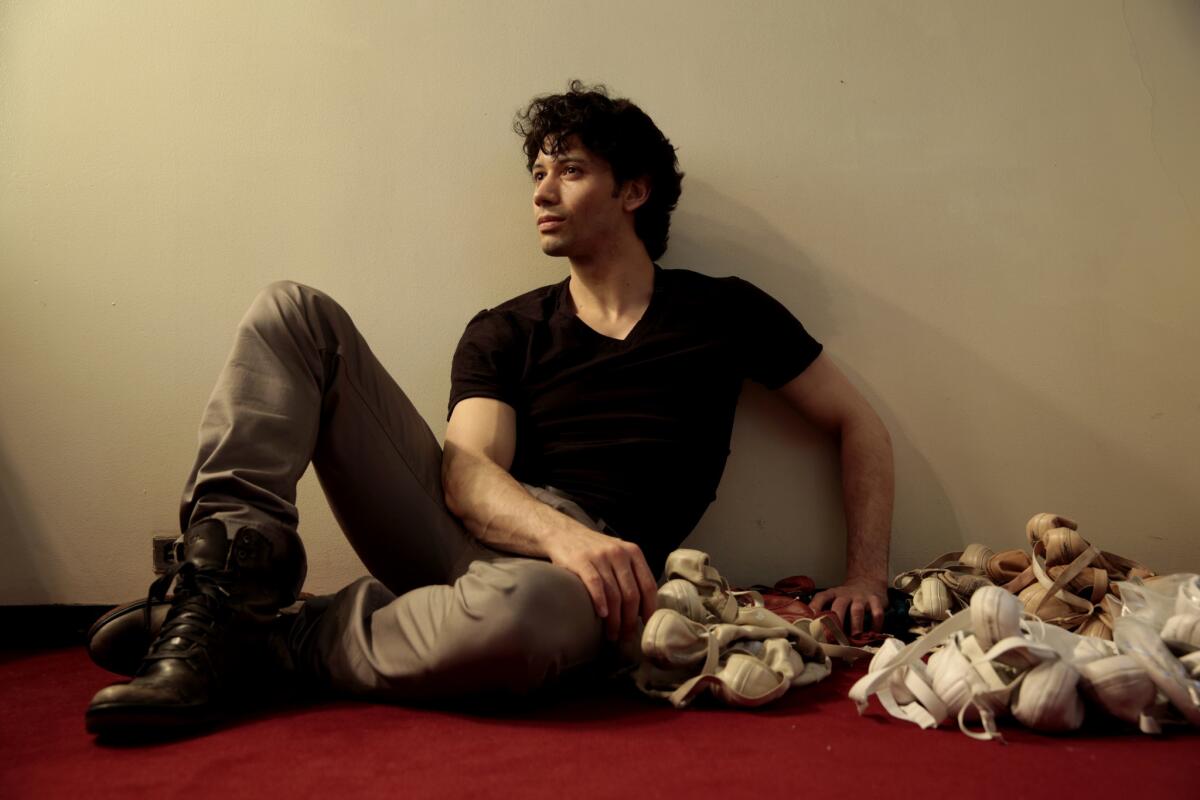Herman Cornejo stands tall in multiple roles in ABT’s ‘Le Corsaire’

NEW YORK — They bound onto the stage, one after another, during the opening scene of American Ballet Theatre’s “Le Corsaire”: four high-flying men, each tearing through space in an attention-getting entrance and establishing a sense of playful “can you top this” competition.
This three-act ballet, which the company brings to the Music Center this week in a new production, has been a consistent showpiece for ABT’s abundance of male talent for 15 years. With its sword-clanking pirates and nubile midriff-baring women who get sold to the highest bidder, “Le Corsaire” is hardly the most profound of ballets, but it provides a rollicking good time and features six juicy leading roles.
Only one ABT principal dancer has performed all four of its lead male roles: Herman Cornejo, who employs his exceptional technique with expressive power and dramatic spontaneity. The Argentine virtuoso had just become an ABT apprentice when the company added “Corsaire” to its repertory in 1998. Now he moves with ease among three of its showcase roles and will perform two very different ones over the weekend.
CRITICS’ PICKS: The best art in town
On July 12, he portrays Conrad, the titular hero — the one character, he observes, dramatically engaged in all three acts. On July 14 he becomes Ali, Conrad’s sensually subservient slave, whose celebrated virtuosic feats are well-known gala fare and became part of Nureyev’s mystique. He finds it the most challenging role of the four because of its associations and expectations: “the audience is used to seeing the role in a certain way, and you need to be able to reach that level of tricks and power.”
For Cornejo, 32, the last two seasons have brought important new challenges. Though among the shorter of ABT’s principal men, he has now moved into all of the major lead roles — normally filled by tall dancers — in its extensive collection of full-length ballets. During the New York season that just concluded, he made debuts as Siegfried in “Swan Lake” and Aminta in “Sylvia” while also performing the heroes of “Don Quixote,” “Romeo and Juliet,” and “Sleeping Beauty.”
“I never actually thought about height for dancers, if you have the right proportions,” Cornejo said at the Metropolitan Opera House, the day after his debut as Siegfried. “I think that issue has more to do with the director’s point of view.”
Cornejo has always been exemplary in mercurial, fleet roles that require precision and daring, not only making complex feats look effortless but taking evident pleasure in them.
A signature role is Puck in Ashton’s “The Dream”; reviewing him last year, New York Times critic Alastair Macaulay praised it as “the most definitive performance of any role to be seen anywhere in ballet today … Mr. Cornejo is an impulsive force of nature, an embodiment of fairy wit and an irresistible source of inventive glee.” He has also given ABT a definitive Mercutio in “Romeo and Juliet,” a role he cherishes and still performs, even after moving on to become an ardent, persuasive Romeo. His performances in ABT’s Paul Taylor and Twyla Tharp works have set high standards; both Tharp and Alexei Ratmansky have created major roles for him.
“It was really clear right away he is a remarkably special talent,” ABT artistic director Kevin McKenzie said by phone. “He has a broad robustness and a soul that sings right through it.” Faced with finding partners who matched Cornejo’s height, he recalls, with a laugh, thinking “maybe he’ll grow.” As it turned, he acknowledged, “he grew in different ways. Of all the careers I’ve witnessed, I think his rise has been the most organic. He did things when he was ready for them.”
Growing up in Buenos Aires, Cornejo discovered his love for ballet at 8 and never looked back. “My parents took me to a sports club when I was 6, and from everything they had, I chose ice skating — just because I felt that I needed to move in a certain way, with the music,” he said recently at the Metropolitan Opera House, the day after his debut as Siegfried. Meanwhile, his sister Erica was studying ballet. “From watching my sister in the studio, I said, I felt this is what I want to do.” He left the rink and joined her at the Instituto Superior de Arte at Teatro Colón.
PHOTOS: Arts and culture by The Times
They both launched impressive careers at an early age, dancing with Ballet Argentino, founded by ABT star Julio Bocca. “We did 200 shows a year, all over the world. I was amazed by the opportunity to be onstage at such a young age and to watch him every day. I learned so much from him.” When the troupe performed in New York in 1995, New York Times critic Anna Kisselgoff took note of the 14-year-old’s “unaffected purity.”
“My dream was to follow Julio Bocca’s steps to ABT,” Cornejo recalled. He didn’t have to wait long; in 1998, at 17, he became an apprentice for the New York season. (Erica also joined ABT, becoming a soloist; she is now a principal with Boston Ballet.) He then spent six months with the ABT Studio Company, and got his corps de ballet contract in 1999. He began performing featured roles almost immediately, and was promoted to soloist in 2000, then principal in 2003.
Also becoming a principal that year was Cuban ballerina Xiomara Reyes, who had joined ABT as a soloist after seven years with Royal Ballet of Flanders. Petite and technically assured, she soon became Cornejo’s regular partner. Speaking from the Met recently, Reyes recalls a “rocky start” to the partnership: “He was thinking I was a diva, and I had the first impression that he was very young, the kind who is only interested in technique. But we put in the amount of time, and our resources, to make it work. I could not be prouder of him. He always had an incredible technique. But he has become this wonderful, mature artist. He didn’t accept any ‘no’ and went for it.”
Cornejo joined ABT when a particularly impressive roster of male talent had emerged during the 1990s. Thanks to him, Marcelo Gomes, David Hallberg and others, the company has continued to showcase exemplary male talent. He describes the atmosphere in the studio as “a clean and nice competition — one that makes you enjoy it more, because you want to do the best.” But he sees his technique as a means to an end. “I always put my acting and storytelling first. When you’re technically secure, then it makes it easier to feel that way.”
McKenzie is his primary coach for his expanding repertory. Cornejo relies on him “not only for partnering, because he was a great partner, but for the details he has about everything — acting and dancing. I can’t think of a better coach. I work with him on almost every ballet. For me it’s rewarding to have a director that you respect. You see that he’s getting the best out of you.”
While ABT has some downtime after this week, Cornejo won’t be resting much. He soon starts rehearsals for a new Martha Clarke dance-theater work, “Cheri,” that pairs him with former ABT star Alessandra Ferri, for performances in November at New York’s Signature Theater. Before that comes ABT’s two-week New York season of mixed-repertory programs, when he expects to be part of “The Tempest,” Alexei Ratmansky’s latest ballet for the company. He has worked often with the choreographer, who most recently created a powerful, nuanced role for Cornejo in his Shostakovich trilogy.
With his expanding repertory of both classics and contemporary works, Cornejo has elegantly and boldly left expectations behind. The phenomenal technique continues to amaze, but he always uses it to express the essence of each role. The possibilities are lovely to contemplate.
American Ballet Theater
Where: Dorothy Chandler Pavilion, Los Angeles
When: Mixed program is 7:30 p.m. July 11; “Le Corsaire” is 7:30 p.m. July 12 and 13 and 2 p.m. July 13 and 14
Cost: $34 to $125
Info: (213) 972-7211or https://www.musiccenter.org
More to Read
The biggest entertainment stories
Get our big stories about Hollywood, film, television, music, arts, culture and more right in your inbox as soon as they publish.
You may occasionally receive promotional content from the Los Angeles Times.










